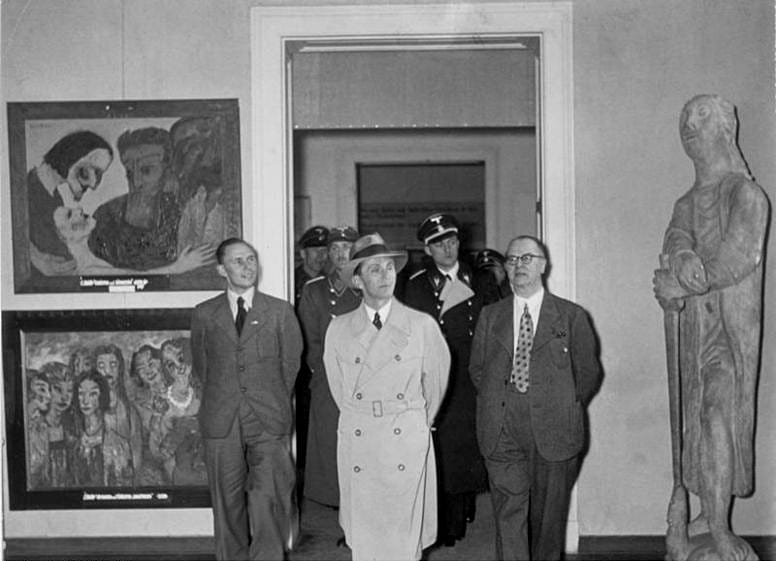- Self Indulgent Claptrap
- Posts
- Navel-gazing in the midst of fascism
Navel-gazing in the midst of fascism
What good is it to sing helplessness blues?

One of those things I really struggle with is attaching value to anything I create. This becomes exacerbated when the things I create seem to be missing the moment. How To Eat A City can seem, even to me as the author, trite and inconsequential in the face of where we are as a country.
To some extent, it is.
We’re in the midst of a crisis (and we’re only just past three months into a four-year term, plus however much longer Trumpism infects American politics) and I’ve chosen to suddenly start publishing a project where I dine out and write about my feelings (often heartbreak and depression). What is the fucking point? The world has enough sad middle-class white boys, surely?
In 1937 Munich, the Nazis staged Die Ausstellung "Entartete Kunst" at the Institute of Archaeology in the Hofgarten. The show of “Degenerate Art” was meant to demean expressionism, cubism, surrealism, and showcased 112 artists who had their work stolen and displayed. Some artists destroyed their work rather than let the Nazis take them. While a handful of rooms had a thematic element (one was “Jewish artists,” and all of modernism was attacked as being Jewish-Bolshevik, despite only six of the artists featured in the exhibit actually being Jewish), most were thrown together with no particular care. Things were hung upside down. Works sold during the Weimer hyperinflation were listed with their wild prices, suggesting that these things were a scam. After the exhibition, when they of course failed to sell, the Nazis burned 5,000 confiscated pieces of art.
Nearby, a newly-built art museum held the Große Deutsche Kunstausstellung or “Great German Art Exhibition,” displaying the Nazis’ preferred romanticism and neo-classicalism.
The Degenerate Art exhibition is one of the world’s most well-attended exhibitions in history. The exhibition for “Great German Art” attracted less than half the visitors.
Now, I’m not trying to liken myself to the persecuted artists of the 1930s Germany—I’m still just a sad middle-class WASP guy with a blog here in 2025. But my point here is to say that art is inherently a political action, and anything that feels transgressive to a fascist regime will be treated the same. The Expressionist Emil Nolde, a fervent Nazi himself, had 33 works at Entartete Kunst as well as being the most confiscated artist under the Nazi regime, with over 1,000 paintings taken, for instance. They don’t care who you are. They don’t care whether your abstract painting shows men dying in the trenches of WW1 or is simple blocks of color. Disagree, agree, or avoid engaging entirely with their politics, it’s all the same to a fascist as long as the aesthetics are wrong.
So my work at How To Eat A City celebrates city life, it celebrates cultural diversity, and it celebrates an emotive, sensitive presentation of masculinity. All of these things run counter to the aesthetics of MAGA and Trumpism, which have a nostalgic yearning for the nonexistent yesteryear exemplified in Thomas Kinkade paintings and John Wayne movies. It’s not explicitly political (that’s what this place is for), but it’s also not apolitical. Nothing is, and those that believe anything can be are laboring under a delusion afforded to them through ignorance, the rarefied air they breathe, or because the other shoe hasn’t dropped yet (or some combination thereof).
Does it have value? I don’t know. I hope so. I’m not cutting a new path with it; like all writers, I’m borrowing heavily from those who came before, stealing from Augusten Burroughs, David Sedaris, Edwige Danticat, Peter Matthiessen, Bruce Chatwin, Dave Eggers, Stuart Dybek, Jonathan Gold…all the writers I’ve ever read who did something similar to at least some aspect of what I’m doing. I have to hope that the particular alchemy feels novel. I’ve dressed it up with some food writing—that’s the Jonathan Gold, if you thought he was the odd man out in that list—but the food is a delivery vehicle for life. It’s an excuse to talk about everything that can’t be captured in food.
What I don’t believe, however, is that it’s merely vainglorious navel-gazing. Even in this moment, I don’t believe that sharing some interiority is without value, anymore than I would say someone painting landscapes or poking around on the piano is engaging in some frivolous. Art is expression, it’s a shout into the void.
Maybe the void won’t shout back, but it’s helpful to know there are other people out in the void, shouting.